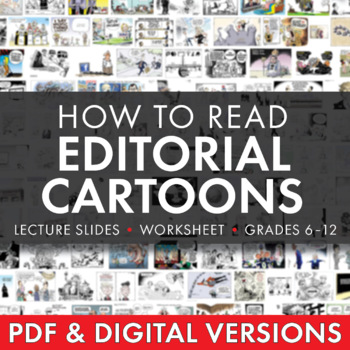Editorial Cartoons Political Cartoons to Teach Persuasion Rhetoric Google Drive
- Zip
- Google Apps™

What educators are saying
Description
Teach your students how to “read” an editorial or political cartoon with this one-day lesson that can also become part of your regular current event assignment rotation. Perfect for English/Language Arts and History/Social Studies classrooms!
The lesson begins with an introduction to four persuasive tools used by editorial cartoonists (symbolism, exaggeration, labeling, and analogy) with real-world examples of classic public domain political cartoons. Then, use modern cartoon examples (links included) to help students see how these same tools are used today. Finally, have students deeply analyze a specific cartoon using the print/post-and-teach worksheet that features eye-catching modern design. The worksheet was designed to be used either as a standalone assignment, emergency sub materials, or part of your weekly or monthly classroom routine.
This “How to Read an Editorial Cartoon” download includes:
• A step-by-step suggested lesson procedure with links to modern editorial cartoon examples (1-page PDF)
• A slide deck lecture (downloads in Prezi, PDF, and Google Slides versions) detailing four persuasive techniques used in classic American cartoons (no U.S. history knowledge is needed to understand the cartoons – all necessary background is included on the lecture slides) (36 “clicks”/slides)
• A fill-in-the-grid worksheet for students to use to analyze any editorial or political cartoon (1-page PDF and Google Drive version)
Looking for more ways to bring non-fiction/informational text into your classroom? Be sure to check out this easy-to-use Current Event Article Close Reading Worksheet.
NOTE: This item is also included in my English 9-10 full-year curriculum. If you already own the full-year download, please do not purchase this item here individually. If you’d like to receive this item plus everything else needed to teach 180 days of English 9 or English 10 at a deeply discounted price, click here to learn more about the full-year curriculum download.
Thanks for stopping by!
Cover image credit: Laura Randazzo, blurred wallpaper background, Fair Use





